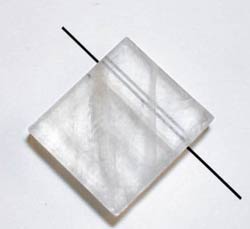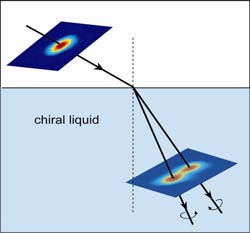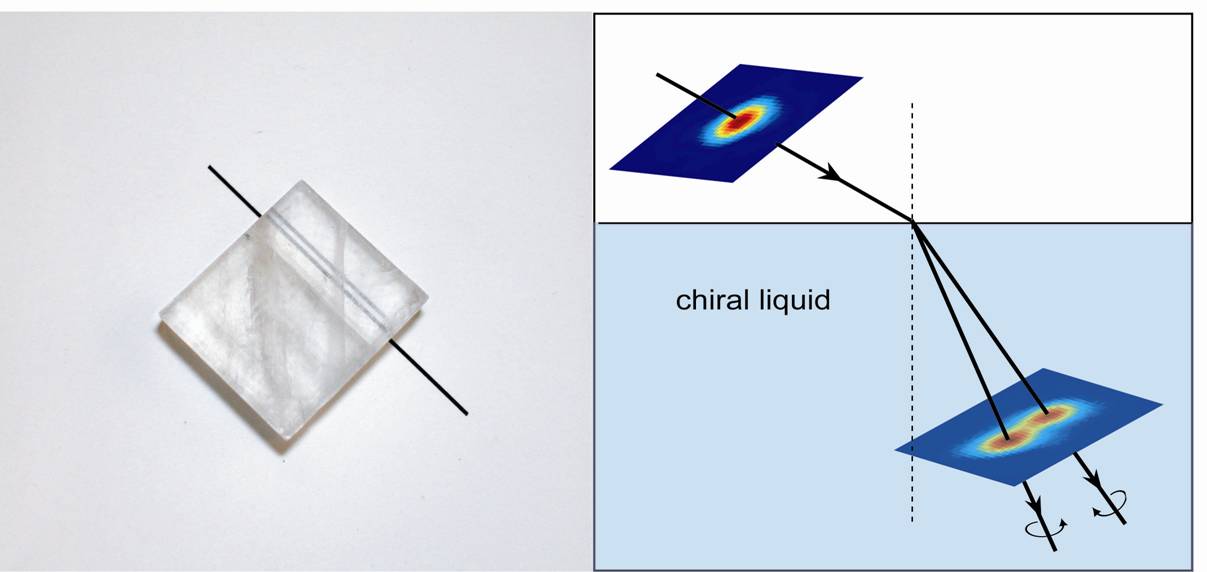Splitting a Light Beam in Two
A beam of light can split in two when entering certain liquids, according to the 27 October PRL. The new experiments demonstrate the effect, predicted almost two centuries ago, and also reveal another phenomenon: a ray can arrive at a boundary at one angle and reflect at a slightly different angle. The work verifies a less-studied aspect of optical physics and may also lead to more sensitive probes of the optical properties of liquids.
Linearly polarized light has wave motion all in one plane, like waves made by jiggling a rope up and down. In the early 19th century, French physicist Augustin Fresnel studied “optically active” materials, which can change the polarization of light. He realized that linearly polarized light can be regarded as equal parts right- and left-circularly polarized light, wave motions that corkscrew in clockwise and counterclockwise fashion. To explain certain experimental findings, he proposed that the two circular polarizations travel at different speeds in optically active liquids.
Since light speed determines the angle of refraction, Fresnel also predicted that linearly polarized light passing into an optically active liquid should split into two separate beams of opposite circular polarization, diverging at an angle related to the difference between the two speeds. While a similar effect is easily seen in anisotropic crystals such as calcite, the divergence angle for liquids is no more than a few ten-thousandths of a degree, say Ambarish Ghosh and Peer Fischer of the Rowland Institute at Harvard University, who have now succeeded in detecting the phenomenon.

It’s now known that optically active liquids consist of so-called chiral molecules, which come in distinct left-handed and right-handed mirror-image forms. Although Fresnel didn’t understand the molecular structures, he and his contemporaries knew that there were two kinds of liquids, which had different effects on linearly polarized light. Fresnel suggested looking for the beam-splitting effect using an arrangement that would amplify it: A sequence of triangular prism-shaped vessels alternately filled with the two types of liquids would increase the divergence angle at each prism face. Ghosh and Fischer used this set-up with the left-handed and right-handed forms of the chiral liquid limonene, a natural scented oil, and clearly imaged the separated beams using a high-resolution camera.
In other experiments, the team looked at “internal” reflection of circularly polarized light traveling through a chiral liquid, hitting the container wall, and then reflecting back into the liquid. The reflection always contains some left- and some right-circularly polarized light, so it creates two reflected rays. But without the elaborate arrangement of prisms, the researchers could only resolve an averaged beam position. Still, they showed that the incident and reflected beams do not make the same angle with the surface–an effect predicted in the 1980s that contradicts the usual law of reflection.
Ghosh and Fischer point out that the beam splitting effect could be used to sensitively analyze the chirality of unknown substances using only a tiny sample. Other techniques require a long “path length” for light going through the sample, but the splitting effect happens right at the interface. Large samples are often not available in medical situations or in future “lab-on-chip” devices.
In a simple proof-of-concept demonstration, the team constructed a small cell, only a few hundred microns across, and filled it with a mixture of the right- and left-handed forms of limonene. By carefully measuring the refracted beam, the researchers could accurately gauge the relative proportion of the two molecular forms.
Ghosh and Fischer have performed an elegant set of experiments, says Mark Silverman of Trinity College in Hartford, Connecticut, who some years ago worked out the full theory of refraction and reflection by chiral media. The application of these effects to microscopic samples is a particularly original suggestion, he adds.
–David Lindley
David Lindley is a freelance science writer in Alexandria, Virginia.





